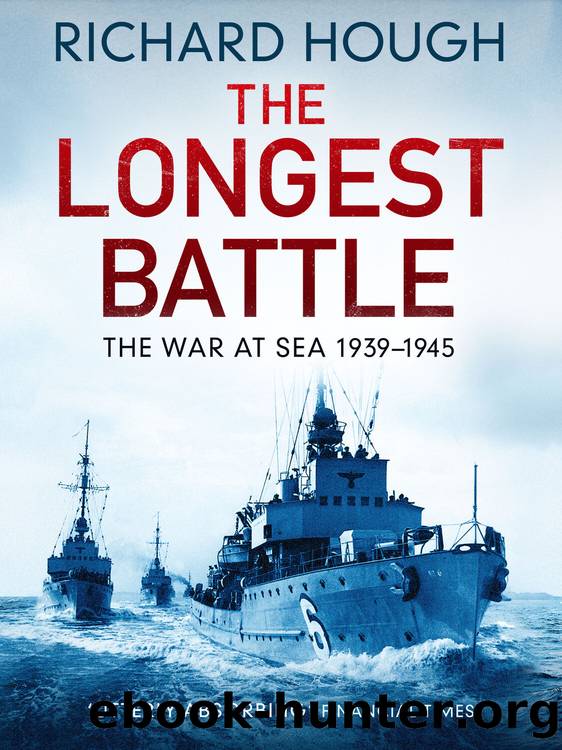The Longest Battle: The War at Sea 1939-1945 by Richard Hough

Author:Richard Hough [Hough, Richard]
Language: eng
Format: epub
ISBN: 9781800325364
Google: eE2azgEACAAJ
Publisher: Canelo
Published: 2021-10-15T23:27:03.486109+00:00
* * *
Admiral Nelson had once declared that when he died, there would be engraved upon his heart the single word âfrigateâ. Never in all his campaigns did he have enough frigates, and this scarcity was a constant anxiety for him. Admiral Chester W. Nimitz in 1942 might have made the same declaration in terms of the aircraft carrier. After the Doolittle raid he had not been able to get the Enterprise and Hornet back in time to support the Lexington and Yorktown in the Coral Sea. After that engagement he could scratch together for operations over the entire Pacific Ocean â one-third of the globeâs surface â just two carriers, the Enterprise and Hornet. The Lexington was lost, her sister ship still recovering from being torpedoed and working up her air group off the west coast of America. The Yorktown, though afloat and mobile, was non-operational from her injuries at Coral Sea, and it would take three months to repair and refit her. The need for a third carrier was desperate.
It was at this point that Admiral King in Washington swallowed his pride and, against all the instincts of his deep Anglophobia, asked for the support of a British carrier from the Far East Fleet. Pride also prohibited him from divulging to the British Admiralty the extent of the American losses at Coral Sea, including the sinking of the Lexington. Dudley Pound was under the impression that the battle had been an overwhelming American victory. King was therefore a victim of his own vaingloriousness and American propaganda, but he did not see it like this.
This is how Admiral King saw things: one American carrier was in the Mediterranean and another in the Atlantic, fighting in a war that King persisted in judging to be of secondary importance, and he therefore reasoned that it was the least the Royal Navy could do to spare one of its fast armoured carriers for the Pacific. What King did not know was that, without reference to Washington, General Douglas MacArthur in Australia had already made a request direct to Churchill for a British carrier only a month earlier and, after Churchill complained to Roosevelt at this short-circuiting of communications, had been turned down, as had a similar request direct to Washington. MacArthur was told to address such future requests properly through the United States Chiefs of Staff in Washington. Roosevelt excused the gaffe by telling Churchill (30 April 1942) that âthe command set-up in Australia is complex and understandings in certain details are reached only as they ariseâ. Just so.
With no possibility of carrier reinforcement from outside, Nimitz just had to make do with what he had: the Enterprise with experienced air crews and high morale; the Hornet with green air crews, which had yet to see action; and the crippled Yorktown. As three carriers were the rock-bottom minimum to face the massive Midway assault, two to attack, one in reserve, the only solution was to do a rapid job on the Yorktown to make her fit for action.
Download
This site does not store any files on its server. We only index and link to content provided by other sites. Please contact the content providers to delete copyright contents if any and email us, we'll remove relevant links or contents immediately.
| Automotive | Engineering |
| Transportation |
Machine Learning at Scale with H2O by Gregory Keys | David Whiting(4190)
Never by Ken Follett(3796)
Urban Outlaw by Magnus Walker(3342)
OPNsense Beginner to Professional by Julio Cesar Bueno de Camargo(3251)
Sapiens and Homo Deus by Yuval Noah Harari(2987)
Will by Will Smith(2794)
A Short History of Nearly Everything by Bryson Bill(2629)
Hooked: A Dark, Contemporary Romance (Never After Series) by Emily McIntire(2502)
Rationality by Steven Pinker(2291)
Borders by unknow(2231)
The Becoming by Nora Roberts(2089)
Holy Bible (NIV) by Zondervan(2087)
The One Percenter Encyclopedia by Bill Hayes(1787)
HBR's 10 Must Reads 2022 by Harvard Business Review(1778)
Freedom by Sonny Barger(1772)
A Short History of War by Jeremy Black(1763)
Five Ways to Fall by K.A. Tucker(1702)
Go Tell the Bees That I Am Gone by Diana Gabaldon(1687)
Girls Auto Clinic Glove Box Guide by Patrice Banks(1685)
